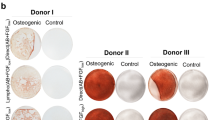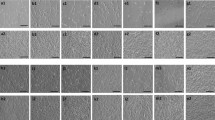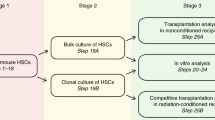Abstract
The immortalized murine stromal cell line AFT024 has been reported to maintain human hematopoietic progenitors in an undifferentiated state in vitro. In the current studies the beige/nude/xid (bnx) mouse in vivo xenograft model was used to examine the engraftment and multilineage generative potential of human hematopoietic progenitors after 2–3 weeks growth on AFT024 stroma, in comparison to primary stromal monolayers derived from post-natal human bone marrow. Eight to 12 months after transplantation of human CD34+CD38− cells from umbilical cord blood, cultured on AFT024 vs human stroma for 2–3 weeks, the murine bone marrow was harvested and analyzed for the presence of human myeloid and lymphoid cells. The mean percent engraftment of total human hematopoietic cells in the murine marrow was significantly higher after co-cultivation on AFT024 than on human stroma. Human myeloid and lymphoid lineage cells were detected in all mice. However, engraftment of myeloid lineage cells (CD33+), B lymphoid (CD19+), and T lymphoid cells (CD4+and CD8+) were significantly higher after co-cultivation of the human cells on AFT024 than on human stroma, prior to transplantation. Interestingly, the length of time in culture did not significantly affect the engraftment of the myeloid and T lymphoid lineage progenitors, but the percentage of B lymphoid lineage engraftment decreased significantly between 2 and 3 weeks of co-cultivation on both types of stroma. Cells with a primitive phenotype (CD45+/CD34−/CD38− and CD45+/CD34−/lin−) and cells with the capacity to generate secondary human CFU after recovery from the bnx bone marrow were maintained at significantly higher levels during culture on AFT024 stroma than on human stroma. The current studies demonstrate that the AFT024 murine stromal cell line supports the ex vivo survival and maintenance of human hematopoietic progenitors that are capable of long-term multilineage reconstitution for 2–3 weeks ex vivo, to levels superior to those that can be obtained using human stromal cells.
This is a preview of subscription content, access via your institution
Access options
Subscribe to this journal
Receive 12 print issues and online access
$259.00 per year
only $21.58 per issue
Buy this article
- Purchase on Springer Link
- Instant access to full article PDF
Prices may be subject to local taxes which are calculated during checkout





Similar content being viewed by others
References
Moore KA, Ema H, Lemischka IR . In vitro maintenance of highly purified, transplantable hematopoietic stem cells Blood 1997 89: 4337–4347
Thiemann FT, Moore KA, Smogorzewska EM, Lemischka IR, Crooks GM . The murine stromal cell line AFT024 acts specifically on human CD34+CD38− progenitors to maintain primitive function and immunophenotype in vitro Exp Hematol 1998 26: 612–619
Punzel M, Moore KA, Lemischka IR, Verfaillie CM . The type of stromal feeder used in limiting dilution assays influences frequency and maintenance assessment of human long-term culture initiating cells Leukemia 1999 13: 92–97
Punzel M, Wissink SD, Miller JS, Moore KA, Lemischka IR, Verfaillie CM . The myeloid-lymphoid initiating cell (ML-IC) assay assesses the fate of multipotent human progenitors in vitro Blood 1999 93: 3750–3756
Punzel M, Gupta P, Roodell M, Mortari F, Verfaillie CM . Factor(s) secreted by AFT024 fetal liver cells following stimulation with human cytokines are important for human LTC-IC growth Leukemia 1999 13: 1079–1084
Barker J, Verfaillie CM . A novel in vitro model of early human adult B lymphopoiesis that allows proliferation of pro-B cells and differentiation to mature B lymphocytes Leukemia 2000 14: 1614–1620
Lewis ID, Verfaillie CM . Multi-lineage expansion potential of primitive hematopoietic progenitors. Superiority of umbilical cord blood compared to mobilized peripheral blood Exp Hematol 2000 28: 1087–1095
Miller JS, McCullar V, Punzel M, Lemischka IR, Moore KA . Single adult human CD34(+)/Lin−/CD38(−) progenitors give rise to natural killer cells, B-lineage cells, dendritic cells, and myeloid cells Blood 1999 93: 96–106
Gallacher L, Murdoch B, Wu DM, Karanu FN, Keeney M, Bhatia M . Isolation and characterization of human CD34(−)Lin(−) and CD34(+)Lin(−) hematopoietic stem cells using cell surface markers AC133 and CD7 Blood 2000 95: 2813–2820
Oh IH, Lau A, Eaves CJ . During ontogeny primitive (CD34(+)CD38(−)) hematopoietic cells show altered expression of a subset of genes associated with early cytokine and differentiation responses of their adult counterparts Blood 2000 96: 4160–4168
Tsuji T, Itoh K, Nishimura-Morita Y, Watanabe Y, Hirano D, Mori KJ, Yatsunami K . CD34high+ CD38(low/−) cells generated in a xenogenic coculture system are capable of both long-term hematopoiesis and multiple differentiation Leukemia 1999 13: 1409–1419
Bhatia M, Wang JCY, Kapp U, Bonnet D, Dick JE . Purification of primitive human hematopoietic cells capable of repopulating immune-deficient mice Proc Natl Acad Sci USA 1997 94: 5320–5325
Petzer AL, Zandstra PW, Piret JM, Eaves CJ . Differential cytokine effects on primitive (CD34+CD38−) human hematopoietic cells: novel responses to Flt3-ligand and thrombopoietin J Exp Med 1996 183: 2551–2558
Hao QL, Shah AJ, Thiemann FT, Smogorzewska EM, Crooks GM . A functional comparison of CD34+ CD38− cells in cord blood and bone marrow Blood 1995 86: 3745–3753
Issaad C, Croisille L, Katz A, Vainchenker W, Coulombel L . A murine stromal cell line allows the proliferation of very primitive human CD34++/CD38− progenitor cells in long-term cultures and semisolid assays Blood 1993 81: 2916–2924
Terstappen LW, Huang S, Safford M, Lansdorp PM, Loken MR . Sequential generations of hematopoietic colonies derived from single nonlineage-committed CD34+CD38− progenitor cells Blood 1991 77: 1218–1227
Wang X, Hong R, Nolta J . Extrathymic human T lymphocyte development and regulation in immune deficient mice Exp Hematol 2000 28: 1500
Tsark EC, Dao MA, Wang X, Weinberg K, Nolta JA . IL-7 enhances the responsiveness of human T cells that develop in the bone marrow of athymic mice J Immunol 2001 166: 170–181
Nolta JA, Hanley MB, Kohn DB . Sustained human hematopoiesis in immunodeficient mice by cotransplantation of marrow stroma expressing human interleukin-3: analysis of gene transduction of long-lived progenitors Blood 1994 83: 3041–3051
Dao MA, Nolta JA . Use of the bnx/hu xenograft model of human hematopoiesis to optimize methods for retroviral-mediated stem cell transduction (review) Int J Mol Med 1998 1: 257–264
Dao MA, Nolta JA . Immunodeficient mice as models of human hematopoietic stem cell engraftment Curr Opin Immunol 1999 11: 532–537
Prochazka M, Gaskins HR, Shultz LD, Leiter EH . The nonobese diabetic scid mouse: model for spontaneous thymomagenesis associated with immunodeficiency Proc Natl Acad Sci USA 1992 89: 3290–3294
Dao MA, Nolta JA . CD34: to select or not to select? That is the question Leukemia 2000 14: 773–776
Dao MA, Shah AJ, Crooks GM, Nolta JA . Engraftment and retroviral marking of CD34+ and CD34+CD38− human hematopoietic progenitors assessed in immune-deficient mice Blood 1998 91: 1243–1255
Nolta JA, Dao MA, Wells S, Smogorzewska EM, Kohn DB . Transduction of pluripotent human hematopoietic stem cells demonstrated by clonal analysis after engraftment in immune-deficient mice Proc Natl Acad Sci USA 1996 93: 2414–2419
Dao MA, Pepper KA, Nolta JA . Long-term cytokine production from engineered primary human stromal cells influences human hematopoiesis in an in vivo xenograft model Stem Cells 1997 15: 443–454
Arakawa-Hoyt J, Dao MA, Thiemann F, Hao QL, Ertl DC, Weinberg KI, Crooks GM, Nolta JA . The number and generative capacity of human B lymphocyte progenitors, measured in vitro and in vivo, is higher in umbilical cord blood than in adult or pediatric bone marrow Bone Marrow Transplant 1999 24: 1167–1176
Bhatia M, Bonnet D, Murdoch B, Gan OI, Dick JE . A newly discovered class of human hematopoietic cells with SCID-repopulating activity (see comments) Nat Med 1998 4: 1038–1045
Fujisaki T, Berger MG, Rose-John S, Eaves CJ . Rapid differentiation of a rare subset of adult human lin(−)CD34(−)CD38(−) cells stimulated by multiple growth factors in vitro Blood 1999 94: 1926–1932
Dao MA, Yu XJ, Nolta JA . Clonal diversity of primitive human hematopoietic progenitors following retroviral marking and long-term engraftment in immune-deficient mice Exp Hematol 1997 25: 1357–1366
Dorrell C, Gan OI, Pereira DS, Hawley RG, Dick JE . Expansion of human cord blood CD34(+)CD38(−) cells in ex vivo culture during retroviral transduction without a corresponding increase in SCID repopulating cell (SRC) frequency: dissociation of SRC phenotype and function Blood 2000 95: 102–110
Bhatia M, Bonnet D, Kapp U, Wang JC, Murdoch B, Dick JE . Quantitative analysis reveals expansion of human hematopoietic repopulating cells after short-term ex vivo culture J Exp Med 1997 186: 619–624
Moore KA, Pytowski B, Witte L, Hicklin D, Lemischka IR . Hematopoietic activity of a stromal cell transmembrane protein containing epidermal growth factor-like repeat motifs Proc Natl Acad Sci USA 1997 94: 4011–4016
Smas CM, Sul HS . Pref-1, a protein containing EGF-like repeats, inhibits adipocyte differentiation Cell 1993 73: 725–734
Laborda J, Sausville EA, Hoffman T, Notario V . dlk, a putative mammalian homeotic gene differentially expressed in small cell lung carcinoma and neuroendocrine tumor cell line J Biol Chem 1993 268: 3817–3820
Shah AJ, Smogorzewska EM, Hannum C, Crooks GM . Flt3 ligand induces proliferation of quiescent human bone marrow CD34+CD38− cells and maintains progenitor cells in vitro Blood 1996 87: 3563–3570
Hao QL, Thiemann FT, Petersen D, Smogorzewska EM, Crooks GM . Extended long-term culture reveals a highly quiescent and primitive human hematopoietic progenitor population Blood 1996 88: 3306–3313
Hao QL, Smogorzewska EM, Barsky LW, Crooks GM . In vitro identification of single CD34+CD38− cells with both lymphoid and myeloid potential Blood 1998 91: 4145–4151
Verfaillie CM, Almeida-Porada G, Wissink S, Zanjani ED . Kinetics of engraftment of CD34(−) and CD34(+) cells from mobilized blood differs from that of CD34(−) and CD34(+) cells from bone marrow Exp Hematol 2000 28: 1071–1079
Nakamura Y, Ando K, Chargui J, Kawada H, Sato T, Tsuji T, Hotta T, Kato S . Ex vivo generation of CD34(+) cells from CD34(−) hematopoietic cells Blood 1999 94: 4053–4059
Sato T, Laver JH, Ogawa M . Reversible expression of CD34 by murine hematopoietic stem cells Blood 1999 94: 2548–2554
Dao MA, Nolta JA . Reversibility of CD34 expression on human stem cells that retain the capacity for secondary reconstitution Blood 2000 96: 581a
Acknowledgements
This work was supported by the NIH NHLBI (SCOR 2-P50-HL54850 and R01HL58739) and the NIH NIDDK (RO1DK53041 and R01DK54567). GMC is a scholar of the Leukemia Lymphoma Society. The authors would like to thank Renee Traub-Workman and Miriam Figueroa for talented and devoted care of our immune-deficient mice. Sally Worttman heads our excellent animal facility and Dr Janet Baer (Caltech) provided highly useful veterinary advice.
Author information
Authors and Affiliations
Rights and permissions
About this article
Cite this article
Nolta, J., Thiemann, F., Arakawa-Hoyt, J. et al. The AFT024 stromal cell line supports long-term ex vivo maintenance of engrafting multipotent human hematopoietic progenitors. Leukemia 16, 352–361 (2002). https://doi.org/10.1038/sj.leu.2402371
Received:
Accepted:
Published:
Issue Date:
DOI: https://doi.org/10.1038/sj.leu.2402371
Keywords
This article is cited by
-
Human delta like 1-expressing human mesenchymal stromal cells promote human T cell development and antigen-specific response in humanized NOD/SCID/IL-2R\(\upgamma \)null (NSG) mice
Scientific Reports (2021)
-
Extrinsic Regulation of Hematopoietic Stem Cells and Lymphocytes by Vitamin A
Current Stem Cell Reports (2018)
-
Engineered Human Stem Cell Microenvironments
Current Stem Cell Reports (2016)
-
Wnt Signaling and the Control of Human Stem Cell Fate
Stem Cell Reviews and Reports (2014)
-
The role of Smad signaling in hematopoiesis and translational hematology
Leukemia (2011)



